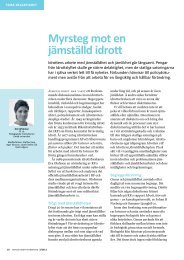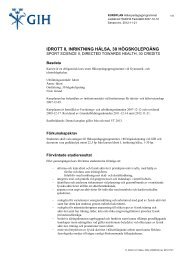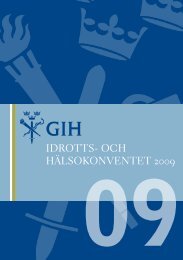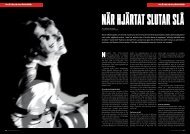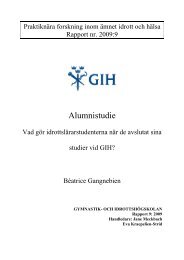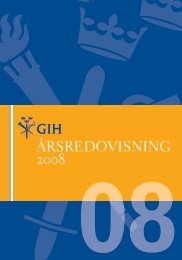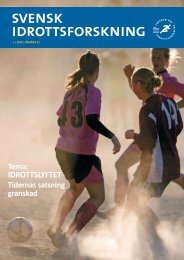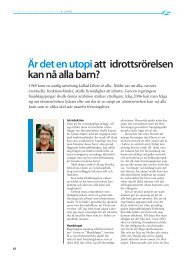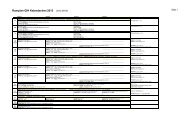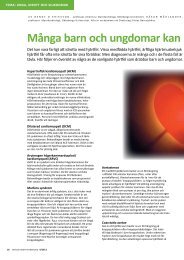Programme and abstracts - GIH
Programme and abstracts - GIH
Programme and abstracts - GIH
You also want an ePaper? Increase the reach of your titles
YUMPU automatically turns print PDFs into web optimized ePapers that Google loves.
Abstracts, Friday June 7 th , 10.00-11.00, Oral paper presentationsTitle:Learning within Places through Intergenerational Encounter: signposts for an intergenerationalplace-responsive outdoor educationAuthor/s:Greg Mannion, School of Education, University of Stirling, Scotl<strong>and</strong> <strong>and</strong> Joyce Gilbert, RoyalScottish Geographical Society, Perth, Scotl<strong>and</strong>Abstract:In this presentation we explore some practice examples from two innovative school-linkedoutdoor learning projects: Journeys in Nature <strong>and</strong> Stories in the L<strong>and</strong>. Journeys in Nature wasbased on an intergenerational approach to travelling within local natural settings. Stories in theL<strong>and</strong> (ongoing) extends that work, supporting schools <strong>and</strong> locals in employing old cattledroving roads as the settings for experimental intergenerational walking <strong>and</strong> story making.Findings suggest that outdoor experiential curriculum based on explorations in local naturalplaces can afford place-responsive, reciprocal forms of learning across the generations(Mannion 2012). Video <strong>and</strong> audio transcripts are analysed to show how learning occurred aspart of intergenerational encounters within places. Theoretically, we argue that learninghappens through creating <strong>and</strong> taking new pathways of movement that reshape the relationsamong teachers, learners, generations, <strong>and</strong> places. Further, we will show that placeresponsive(Mannion et al 2012) pedagogies can have critical purchase on the creation ofmore inclusive, sustainable ways of life because they dem<strong>and</strong> in learners responses to eachother, <strong>and</strong> to changing <strong>and</strong> contingent environments.Title:"Outdoor in projects - work with youth <strong>and</strong> the unemployed people".Author/s:Katarina Jurewicz, TWIKS, Pol<strong>and</strong>.Abstract:Multimedia presentation prepared by TWIKS Association from Pol<strong>and</strong>:"Analysis of non-formal education influence on social <strong>and</strong> professionalactivation" in context of activities conducted by TWIKS Association foryouth <strong>and</strong> adults, including unemployed, h<strong>and</strong>icapped <strong>and</strong> people fromsmall cities. The role of non-goverment organisations in socialactivisation development through non-formal education will be illuminated.Title:Dimensions of place in school-based outdoor educationAuthor/s:Emilia Fägerstam, National Centre of Outdoor Education, Linköping University, Sweden.Abstract:Dimensions of place in outdoor <strong>and</strong> environmental education research are gaining increasedattention (Ardoin, Schuh & Gould, 2012). School-based outdoor education can be defined asacademic education which takes place outdoors. Learning about the place is sometimes thefocus but the place can also be an arena for activities aimed at developing social <strong>and</strong> personalskills or a ‘sense of place’. Place is a multidimensional <strong>and</strong> ambiguous concept which needsmore attention in educational research (Nespor, 2008; Van Eijck & Roth, 2010). A theory ofplace guided the analysis in this research. Place <strong>and</strong> space have received considerableattention in disciplines such as geography, psychology, sociology <strong>and</strong> recently also ineducational research. Drawing on a phenomenological tradition, place can be conceptualizedas ‘insideness’ <strong>and</strong> belonging to a place (Relph, 1976; Tuan, 1977) but also as an openevolving social space (Massey, 2005), emphasizing socio-cultural <strong>and</strong> relational dimensions.22




